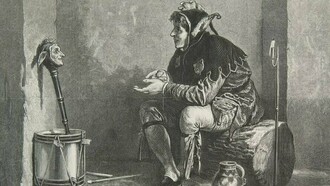In what is known as the bloodiest chapter in the history of France, the goddess Liberté was reimagined. This ancient Roman goddess became a symbol of equality and freedom for a people whose nation was wrought with civil unrest. The French Revolution was explosive in its use of symbolism. At one point, a glossary was needed to be printed alongside an image of Liberté titled Directoire Éxécutif (1795-1798) by Jean Claude Naigeon (1753-1832), so the citizens of France were able to properly identify all the meanings of the symbolism accompanying her image. It was this broad usage of Liberté that allowed the promotion of revolutionary ideals quickly and effectively amongst the French people1. Liberté, the allegory for civil rights and freedom, is represented in different ways throughout the French Revolution.
Before the Revolution, the use of goddesses in art was not a new phenomenon. Goddesses, such as Venus, were used throughout Rococo artworks, typically telling a dramatic story concerning their divine being. Tales answered how they fell in or out of virtue or a story of how they fell in love or had their heart broken. This is seen in The Triumph of Venus by François Boucher (1703-1770), painted in 1740, which depicts Venus rising from the sea. Zephyrus, the god of wind, is seen placing a crown on her head, while Triton, god of the sea, cupids, and nymphs surround her. These types of depictions were also seen in Rococo sculptures, for example, in Prometheus (1762) by Nicolas-Sébastien Adam (1705-1778), in which a vulture is ripping apart Prometheus’ skin to eat his liver; a punishment from Zeus for gifting humans with fire. The difference between the Rococo style depictions of goddesses and that of Liberté during the French Revolution is that the former was absent of iconography. Author Madelyn Gutwirth elaborates:
This was a revival, divorced from scenes of mythology, which would install the feminine noun and its female visualization in place of the rococo as the realm of (female) alterity. Whether “hot” and sexually suggestive, or “cool,” remote, and monumental, allegory tends to remove the idea of a woman from the play of passion and contention2.
This change in artistic style from the topically buoyant and ornamental to the simplicity of realistic form and social events best marked its triumph in France during the Salon of 1785 through the artwork Oath of the Horatii, created in 1784 by Jacques-Louis David (1748-1825)3. Speaking on the importance this painting had on the stylistic change seen, art historian Arnold Hauser states:
This […] has its origin in the republican virtues […] The fact that the upper classes join […] given what we know of the infectious power of successful movements, nothing so astonishing as the fact that even the government gave this support to it. […] It is now declared that art must not be an idle pastime, a mere tickling of the nerves, a privilege of the rich and the leisured, but that it must teach and improve, spur on to action, and set an example4.
While there was a change in artistic style, for the most part, political iconography did not reach far into the fine arts. In fact, during the years of the French Revolution, 1789 to 1799, less than ten percent of the paintings shown at the salons were political in nature5. This was in part due to the rapidly changing political sentiments. An artist could quickly create and reproduce an engraving or cartoon to then swiftly distribute it amongst the population. Many new newspapers opened up in 1789, and they were all covered in printed images of Liberté and political propaganda. Similarly, calendars, jewelry, medals, and much more were used as vehicles to push ideals through art. Prints proved to be the most effective way to adjust the image of Liberté to quickly meet the needs of the Republic, as they could be easily and swiftly produced to spread new ideals.
The use of iconography became apparent at the very start of the Revolution in 1789 and there were many different symbols used alongside Liberté throughout the French Revolution6. The image that best marks the beginning of the French Revolution and the symbolism surrounding Liberté is an engraved coin, created in the summer of 1789 by the artist Augustin Dupré (1748-1833). In this engraving, Liberty is reclining comfortably on a column, dressed in a Roman-inspired tunic, that clings to her curved figure. The engraved coin is packed with symbolism, the most prominent being the turreted crown she is wearing, the fasces by her side, the rudder she is holding in one hand, and the staff she is holding in her other, which is topped with a Phrygian cap7.
The rudder symbolizes the ability to create change, while the sheaf of wheat represents prosperity and what is essential to the nourishment of the people. Her turreted crown, also known as a mural crown, is a type of military headdress that appears on fortress walls. Historically, it would be gifted to the first soldier in the battle to scale the wall of a city, therefore associated with valor 8. The fasces was also a prevalent symbol featured alongside many depictions of Liberté during the French Revolution, symbolizing power and justice. This symbol originated from the Etruscan civilization of Ancient Italy, their symbolism and use became popular in Ancient Rome, expanding into France during the Revolution. While these were all powerful symbols, it would be the Phrygian cap that made the biggest impact throughout the history of France when accompanied by Liberté.
The Phrygian cap, originating in Rome, was the symbol of freed slaves. Upon receiving the cap, a ceremony would be held called ‘capture pileum’, meaning ‘to take the cap,’ in which the cap would be offered to the slave, after which they were ‘touched’ with a ceremonial staff9. The Phrygian cap was quickly used as iconography to symbolize revolution as early as 44 B.C. after Julius Caesar was assassinated. Brutus placed the cap on one side of a coin, accompanied by his image on the other, staging himself on the side of the popular Republic. Before its use in the French Revolution, the cap was not forgotten, being documented in art through the decades, but its shape changed slightly, leaving behind the slack tip, and taking on a more bell-like shape. Dupré, after a failed attempt at making the bell-shaped version of the cap and a goddess as the seal for the United States, used his new 1789 design to commemorate the new Mayor of Paris placing Liberté on the opposite side of the coin.
Dupré’s 1789 version of the Phrygian cap brought back the slack tip. The exact reason Dupré depicted this version of the Ancient Roman freedom cap, instead of his original bell version is unknown, but there are a few speculations. The first is that the slack shape of the cap pictured on Dupré’s coin may have been influenced by a similar style of headwear worn by working men at the time, as can be seen in a print titled Garçon Boulanger from 1730 by Edme Bouchardon (1698-1762). The second influence Dupré may have had was from his friend Jacques-Louis David (1748-1825) who, in the same summer of 1789, finished his painting The Loves of Paris and Helen, in which Paris, from Homer’s Iliad, is wearing a Phrygian cap with a slack tip. The Phrygian cap was an effective symbol of liberation and freedom during the French Revolution, so much so that in later years, for a time, it needed to be abandoned in artist depictions due to its radical symbolism10.
Dupré’s 1789 commemorative coin speaks strongly to the social climate of what was going on in France at the time. In July of 1789, the Bastille was stormed, marking one of the first actions by the French people that led to the French Revolution. Furthermore, after the taking of the Bastille, the mayor of Paris, Jacques de Flesselles (1730-1789), was accused of obstructing the people's cause and murdered. His head was then put on the tip of a spear and paraded through the streets; a horrific scene which was documented by one of Dupré’s protégées in a sketch. Dupré’s edition of the Phrygian cap on top of a staff on his Mayoral commemoration coin is not only eerily symbolic of the carnage described but also brings attention back to the Ancient Roman’s ceremonial ‘capture pileum’ and freeing of the slave. The symbolism that accompanies Liberté in this engraving signals hope for the future of France and its people.
In response to the continuing issues surrounding the General Estates, in 1789 the Third Estate succeeded in creating their branch of government called the National Assembly. In 1792, once the First Republic of France was established, there was an immediate need to substitute the King’s image in the Revolution’s fight; the National Assembly quickly chose Liberté as the official seal. Gutwirth concurs, ‘As the monarchy’s prestige withered […] the use of a woman as an alternative symbol of the nation comes in to replace the monarch as effigy11.’
The seal was very close in depiction to Dupré’s earlier version of Liberté from 1789. The seal illustrated Liberté, with a relaxed posture, wearing a Roman tunic that folds and hangs on her feminine curves. She is still crowned, holding a fasces in one hand and a staff with the Phrygian cap on its end in the other. Subsequently, she was placed on crests, medals, letterheads, and prints, standing for the face of the First Republic and their civil fight for liberty and equality.
The reimagining of Liberté during the French Revolution transformed her into a powerful emblem of liberation, equality, and resilience. From her ancient Roman origins to her radicalized portrayal with the Phrygian cap, Liberté became a unifying figure in a time of upheaval and transformation. Her symbolism, carefully crafted through art, coinage, and iconography, reflected the aspirations and tensions of a nation struggling to redefine itself. As the monarchy's power diminished, Liberté rose to embody the ideals of the Republic, serving not only as a figure of hope but as a vehicle for political change. Through her evolving depictions, she cemented her role as a timeless icon of revolutionary ideals and the enduring pursuit of freedom.
References
1 Lynn Hunt, ‘Engraving the Republic: Prints and Propaganda in the French Revolution’, History Today, 30.10 (1980) 17.
2 Madelyn Gutwirth, The Twilight of the Goddesses: Women and Representation in the French Revolutionary Era. (New Brunswick, New Jersey: Rutgers University Press, 1992), 252-53.
3 Arnold Hauser, ‘Revolution and Art’, in The Social History of Art: Rococo, Classicism, and Romanticism. Volume 3, (London: Routledge, 1999), 133-34.
4 Hauser, ‘Revolution and Art’, 135.
5 Hunt, ‘Engraving the Republic’, 13.
6 Hunt, ‘Engraving the Republic’, 15.
7 Yvonne Korshak, ‘The Liberty Cap as a Revolutionary Symbol in America and France’ in Smithsonian Studies in American Art, 1.2 (1987), 64.
8 Aulus Gellius, ‘Chapter V’, in The Attic Nights of Aulus Gellius, trans. By William Beloe (London: J. Johnson, St. Paul’s Church-Yard, 1795), 298.
9 Korshak, ‘The Liberty Cap’, 55-62.
10 Richard Wrigley, ‘Transformations of a Revolutionary Emblem: The Liberty Cap in the French Revolution’, French History, 11.2 (1997), 131; Korshak, ‘The Liberty Cap’, 15.
11 Gutwirth, The Twilight of the Goddesses, 253.














